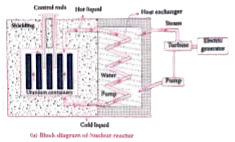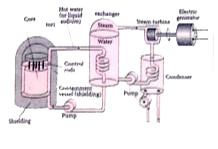What are the uses of nuclear reactor ?Solution in Tamil
Video Solution
Text Solution
Nuclear reactor is a system in which the nuclear fission takes place in a self-sustained controlled manner and the energy produced is used either for research purpose or for power generation. The main parts of a nuclear reactor are fuel, moderator and control rods. In addition to this, there is a cooling system which is connected with power generation set up.
Fuel :
(i) The fuel is fissionable material, usually uranium or plutonium. Naturally occurring uranium contains only 0.7% of and 99.3% are only . So the must be enriched such that it contains at least 2 to 4% of .
(ii) A neutron source is required to initiate the chain reaction for the first time. A mixture of beryllium with plutonium or polonium is used as the neutron source.
(iii) During fission of , only fast neutrons are emitted but the probability of initiating fission by it in another nucleus is very low.
(iv) Slow neutrons are preferred for sustained nuclear reactions.
Moderators :
(i) The moderator is a material used to convert fast neutrons into slow neutrons. Usually the moderators are chosed in such a way that it must be very light nucleus having mass comparable to that of neutrons.
(ii) Hence, these light nuclei undergo collision with fast neutrons and the speed of the neutron is reduced (Note that a billiard ball striking a stationary billiard ball of equal mass would itself be stopped but the same billiard ball bounces off almost with same speed when it strikes a heavier mass.
(iii) This is the reason for using lighter nuclei as moderators). Most of the reactors use water, heavy water and graphice as moderators.
(iv) The blocks of uranium stacked together with blocks of graphite (the moderator) to form a large pile.

Control rods :
(i) The control rods are used to adjust the reaction rate.
(ii) During each fission, on an average 2.5 neutrons are emitted and in order to have the controlled chain reactions, only one neutron is allowed to cause another fission and the remaining neutrons are absorbed by the control rods.
(iii) Cadmium or boron acts as control rod material and these rods are inserted into the uranium blocks.
(iv) Depending on the insertion depth of control rod into the uranium, the average number of neutrons produced per fission is set to be equal to one or greater than one.
(v) If the average number of neutrons produced per fission is equal to one, then reactor is said to be in critical state.
(vi) If it is greater than one, then reactor is said to be in super-critical and it may explode sooner.
Shielding :
For a protection against harmful radiations, the nuclear reactor is surrounded by a concrete wall of thickness of about 2 to 2.5 m.

Cooling system :
(i) The cooling system removes the heat generated in the reactor core.
(ii) Ordinary water, heavy water and liquid sodium are used as coolant since they have very high specific heat capacity and have large boiling point under high pressure.
(iii) This coolant passes through the fuel block and carries away the heat to the steam generator through heat exchanger.
(iv) The steam runs the turbines which produces electricity in power reactors.
|
Updated on:21/07/2023
Similar Questions
नाभिकीय रियेक्टरों में नियंत्रक छड़े किस प्रयोग में लायी जाती है ?
View Solutionनाभिकीय रिएक्टर में प्रयुक्त होने वाला ईंधन है
01:39View SolutionWhat is the fuel used in a nuclear reactor?
00:21View SolutionWhat is used as moderator in nuclear reactor:
02:19View Solutionनाभिकीय रिएक्टर में केडमियम की छड़ का उपयोग किस लिए किया जाता है?
02:22View Solutionनाभिकीय रिएक्टर में मंदक के रूप में क्या प्रयुक्त होता है?
02:41View Solutionनाभिकीय रिएक्टरों में नियन्त्रक छड़ें (control rods) किस लिए प्रयोग में लायी जाती हैं?
View Solutionनाभिकीय रिएक्टरों में नियन्त्रक छड़ें (control rods) किस लिए प्रयोग में लायी जाती हैं?
View Solution

